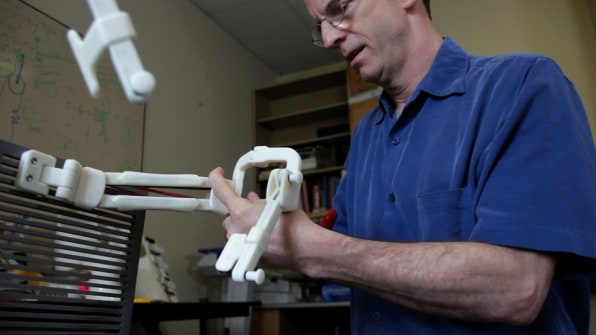How To Play A Chaotic Evil Character In D&d
In the last few years, we've seen everything from handcuff keys to prescription medication emerge from the beds of 3-D printers. But Emma Lavelle's story is one of the most compelling examples of the technology in recent memory.
Emma was born with a rare congenital disorder called arthrogryposis, which prevents her from being able to move her arms. Older children and adults suffering from arthrogryposis and similar conditions can use robotic prosthetics to gain control over their movements. But at only two years old, Emma was too small to qualify as a candidate for such devices.
Still, at an arthrogryposis conference in Philadelphia, her mother saw the inventors of one of the most successful systems–Wilmington Robotic Exoskeleton, or WREX–present their work, and was so impressed that she contacted them anyways. A few weeks later, Lavelle and her daughter were in Tariq Rahman and Whitney Sample's playroom/workshop at Nemours/Alfred I. duPont Hospital for Children. A test run with WREX confirmed their fears–WREX's heavy metal parts were too big for Emma's small frame. Unphased, Rahman and Sample began throwing around ideas for a smaller, lighter version of WREX that would work for toddlers like Emma.
"We thought, well, we could print it out for her," remembers Rahman, referring to his lab's 3-D printer, which offered the only viable way to fabricate such tiny parts. They designed a plastic "jacket" that would let Emma use her body weight to manipulate the arms, and redesigned the WREX hardware to fit the ergonomics of a 2-year-old. "It really started as a method of creating quick size and function prototype," Sample tells Co.Design. "But we found them to be durable, light, and relatively quick to make and replace." He got to work modeling the pieces and printed out a prototype, using the same durable plastic used to make Lego.
For Emma, the benefits of WREX were immediate. "The weight difference is significant," says Emma's mom in a video about the lab. "She outgrew it, and now we're on our second jacket. It's still evolving and growing into this incredible prosthetic." As she grows, Sample has been able to 3-D print replacement parts and rejigger sizing to fit her changing frame–a process that would be exponentially slower and more expensive with traditional machining techniques. "This is one of those industries that matches perfectly with 3-D printing, and additive manufacturing, because we need custom everything," Sample says. The machines are also incredibly precise. "This is particularly an issue when dealing with parts as small as needed for a 2-year-old toddler," he adds.

Sample got his start in the robotics field at Carnegie Mellon, where he received a BFA in Industrial Design. "It's pretty safe to say I'm not your typical designer," he says over email, explaining that his engineer friends at CMU were a major influence–though he doesn't self-identify as an engineer, either. "I'm just a creative practical fabricator who's learned a lot from taking things apart to see how they work AND being able to reassemble them afterwards." After working on human service robots at school, taking a job at Nemours' Applied Science and Engineering Lab was a "natural transition." Collaborating with Rahman at his Pediatric Engineering Research Lab, Sample is able to apply his background in design and fabrication to very real challenges in medicine.
Since their success with Emma's case, the team has printed WREX jackets for more than a dozen other toddlers. "Without the 3-D printer, we wouldn't be in the position we're in with these younger kids," says Rahman. In a video about the system, Rahman and Sample remember the moment when Emma uttered her first complete sentence, after they took her jacket off to make adjustments: "I want that."
How To Play A Chaotic Evil Character In D&d
Source: https://www.fastcompany.com/1670482/3-d-printed-magic-arms-let-a-toddler-hug-and-play
Posted by: ingramnotneinme.blogspot.com

0 Response to "How To Play A Chaotic Evil Character In D&d"
Post a Comment